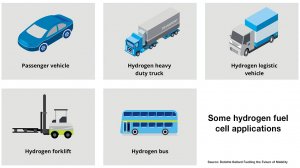Platinum-based hydrogen fuel cell vehicles forecast to be TCO unrivalled by 2026/7


Hydrogen fuel cell electric vehicles are forecast to take the competitive high road.
JOHANNESBURG (miningweekly.com) – The total cost of ownership (TCO) of platinum-based hydrogen fuel cell electric vehicles (FCEVs) is forecast to be less than that of battery electric vehicles (BEVs) by 2026, and less than that of internal combustion engines (ICEs) by around 2027, with an overall estimated 50% FCEV cost decline in the next ten years.
Furthermore, FCEVs are demonstrably greener and cleaner and more environment-friendly across their entire lifecycle than BEVs and ICEs, with more improvements to come as hydrogen production shifts toward a broader role in renewable energy development.
Ballard Power Systems CEO Randy MacEwen notes that society has consistently proven that when it comes to innovation and disruption, 'it’s always slow – until it’s not'. His expectation is that the energy transition, including the adoption of low-carbon hydrogen and fuel cell vehicles in heavy mobility, will happen at scale much faster than most industry reports are forecasting.
“In 2030, with the benefit of an obvious tipping point, many will be looking back to 2023 with revisionist history saying, ‘of course this was going to happen’,” adds MacEwen on LinkedIn.
Platinum-based fuel cells are already used in various mobiity applications.
TCO-wise they might not yet compete with BEVs in the passenger vehicle sector, but significant advantages exist for high loads and when longer ranges are required.
Responding to a series of questions on queries around the technical and economic viability of platinum-based fuel cells, Heraeus Precious Metals executive VP new business development and innovation Philipp Walter highlights to Mining Weekly that the current landing zone for fuel cells is primarily in the heavy-duty bus, train and perhaps maritime areas.
With the expected economy of scale, cheaper green hydrogen through scale and optimisation and an infrastructure converted to hydrogen, fuel cells will, Walter says, also hit the passenger vehicle sector and compete with BEVs and ICEs head to head.
“It’s basically not reasonable to predict the future of fuel cells based on the past, as several parameters have changed. Today’s fuel cells are significantly improved in terms of cost and performance compared with those of the first generation. It's ajourney that has started and has not reached its end so far.
"Sustainability and decarbonisation became a strong impetus to energy and mobility strategies of various regions and countries, giving a significant push to alternatives to ICEs, including FCEVs.
“BEVs have their space in the future mobility concepts, as do FCEVs and ICEs will not fade away overnight. Comparing the life cycle of BEVs with a range up to 250 km it can be stated, depending on energy mix, that they are environmentally more friendly.
“However, BEVS with big battery packs are burdened with a heavy carbon dioxide rucksack (battery capacity above 50 kWh). Especially for trucks and larger passenger cars, FCEVs are the more climate- and customer-friendly solution.
“For applications where ICEs are under replacement due to decarbonisation efforts and long ranges and constant use of a vehicle is demanded, FCEVs are the way to go anyhow," he says.
A study by Deloitte and Ballard entitled ‘Powering the Future Mobility’ provides answers to the economic viability of FCEVs and highlights hydrogen as once again taking centre stage in humanity’s quest for energy sources.
Taking a bottom-up approach of TCO analysis across the US, China, and Europe over a 13-year timespan in FCEVs forecast leadership at the TCO level, the study forecasts that the energy efficiency of FCEVs will see dramatic improvement.
Furthermore, the authors of the Deloitte Ballard study describe their TCO superiority conclusion as being relatively conservative in several aspects.
“For example, as history would show with emerging technologies, production costs often decrease much more dramatically than forecast. We have also not included any government subsidies and incentives (acquisition, infrastructure, or operational) in the TCO model.
“When looking at the specific case scenarios in Shanghai, California, and London, the cross-over of FCEVs with BEVs and ICE vehicles are much faster, due to a variety of subsidies on FCEVs in each geography, or additional taxes on ICE vehicles or fuel,” the study states.
On fuel cells potentially not using platinum, Walter draws attention to proton exchange membrane (PEM) technology in response to Mining Weekly: “There are fuel cell technologies, which do not rely on precious metals, and then there is the PEM fuel cell technology, which is based on platinum as electrochemically active material mainly, and the PEM technology is by far the most prominent one in mobility applications.”
He also draws attention to the Deloitte Ballard study calculating that only up to 1% of the cost of a fuel cell stack system is platinum-related.
Furthermore, as with all precious metal-based ‘mass’ applications, thrifting will always occur to bring down further the use rate and the cost, as has happened with solar panels, autocatalysts and electrolysers.
So far, there are only scientific approaches towards PEM fuel cells that are free of platinum group metals (PGMs).
“As Heraeus Precious Metals, we believe that stability and high performance will require platinum in fuel cells also in the future, at least for quite some time,” says Walter.
HEAVY-DUTY VEHICLE REGULATION INCLUDES HYDROGEN
The European Commission’s allowing for a wider range of hydrogen powertrain propulsion systems for use in the decarbonisation of the multi-faceted commercial transport sector has drawn welcome response from Hydrogen Europe mobility policy director Darko Levicar, who describes the revised carbon dioxide emissions standards for heavy-duty vehicles as an incentive for the scale-up of hydrogen-powered solutions in the European commercial road transport fleet, with hydrogen powertrains being very well placed to meet operational requirements in a wide range of use cases.
To support the ongoing efforts to lower carbon emissions from the road transport sector, he believes that all technologies that can contribute should be given a chance to do so.
“Member States should foster a market in which commercial vehicle operators have multiple ways to transition away from fossil fuels. This will benefit the environment and the European economy,” says Levicar.
Road transport is responsible for one-fifth of the European Union’s greenhouse-gas emissions.
Under the proposed rules, heavy vehicles will be mandated to reduce their emissions by 45% by 2030 and 90% by 2040, and city buses at zero emissions by 2030, targets which are viewed as striking an acceptable balance between ambition and feasibility.
Stringent reduction targets are seen as supporting the efforts of the European automotive industry to transition to zero-emission operations.
Hydrogen Europe estimates that at least 50 000 hydrogen trucks will be in commercial operation by the end of the decade.
A dense hydrogen refuelling network will need to be in place in time to enable mass rollout of hydrogen-powered trucks, buses and coaches.
INDIA DEVELOPING HYDROGEN TRAIN
The World Platinum Investment Council (WPIC) has reported on LinkedIn that India is currently developing a prototype of a hydrogen train at the Northern Railway workshop.
WPIC adds that Indian Railways is looking to introduce hydrogen-fuelled trains on its narrow gauge heritage routes by the end of this year.
Massive imports of platinum into China have been observed since 2021, which some see as China potentially gearing up for major hydrogen economy momentum.
There is considerable global movement the world over that points to earnestness in the energy transition to ensure that Mother Earth benefits and less climate-related destruction is witnessed in the years ahead. Climate change is increasingly being seen as a harsh reality that affects everyone and must be mitigated with great vigour.
Article Enquiry
Email Article
Save Article
Feedback
To advertise email advertising@creamermedia.co.za or click here
Press Office
Announcements
What's On
Subscribe to improve your user experience...
Option 1 (equivalent of R125 a month):
Receive a weekly copy of Creamer Media's Engineering News & Mining Weekly magazine
(print copy for those in South Africa and e-magazine for those outside of South Africa)
Receive daily email newsletters
Access to full search results
Access archive of magazine back copies
Access to Projects in Progress
Access to ONE Research Report of your choice in PDF format
Option 2 (equivalent of R375 a month):
All benefits from Option 1
PLUS
Access to Creamer Media's Research Channel Africa for ALL Research Reports, in PDF format, on various industrial and mining sectors
including Electricity; Water; Energy Transition; Hydrogen; Roads, Rail and Ports; Coal; Gold; Platinum; Battery Metals; etc.
Already a subscriber?
Forgotten your password?
Receive weekly copy of Creamer Media's Engineering News & Mining Weekly magazine (print copy for those in South Africa and e-magazine for those outside of South Africa)
➕
Recieve daily email newsletters
➕
Access to full search results
➕
Access archive of magazine back copies
➕
Access to Projects in Progress
➕
Access to ONE Research Report of your choice in PDF format
RESEARCH CHANNEL AFRICA
R4500 (equivalent of R375 a month)
SUBSCRIBEAll benefits from Option 1
➕
Access to Creamer Media's Research Channel Africa for ALL Research Reports on various industrial and mining sectors, in PDF format, including on:
Electricity
➕
Water
➕
Energy Transition
➕
Hydrogen
➕
Roads, Rail and Ports
➕
Coal
➕
Gold
➕
Platinum
➕
Battery Metals
➕
etc.
Receive all benefits from Option 1 or Option 2 delivered to numerous people at your company
➕
Multiple User names and Passwords for simultaneous log-ins
➕
Intranet integration access to all in your organisation















